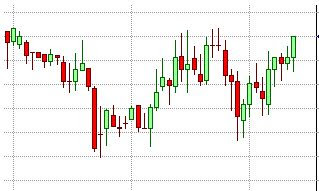line chart
Bar chart
Bar charts are one of the most popular forms of stock charts and are probably the most widely used charts. Bar charts are drawn on a graph that plots time on the horizontal axis and price levels on the vertical axis. The chart consists of a series of vertical bars that indicate various price data for each time-frame on the chart. This data can be either the open price, the high price, the low price and the close price, making it an OHLC bar chart, or the high price, the low price and the close price, making it an HLC bar chart. The height of each OHLC and HLC bar indicates the price range for that period with the high at the top of the bar and the low at the bottom of the bar. Each OHLC and HLC bar has a small horizontal tick to the right of the bar to indicate the close price for that period. An OHLC bar will also have a small horizontal tick to the left of the bar to indicate the open price for that period.The extra information is one of the reasons why the OHLC charts are more popular than HLC charts. In addition, some charting applications use colors to indicate bullish or bearishness of a bar in relation to the close of the previous bar. This makes the OHLC bar chart quite similar to the candlestick chart, except that the OHLC chart does not indicate bullishness or bearishness of the period of one bar as clearly as the candlestick chart (the color of an OHLC bar is always in relation to the close of the pervious bar rather than the open and close of the current bar).
Point and Figure Charts
Point and Figure (P&F) charts date back to at least 1880's and differ from other stock charts as it does not plot price movement from left to right within fixed time intervals. It also does not plot the volume traded. Instead it plots unidirectional price movements in one vertical column and moves to the next column when the price changes direction. It represent increases in price by plotting X's in the column and decreases in price by plotting O's. Each X and O represents a box of a set size or price amount. This box size determines how far the price must move before another X or O is added to the chart, depending on the direction of the price movement. Thus if the box sixe is set at 15, the price must move 15 points above the previous box before the next X or O is plotted. Any movement below 15 is ignored. For this reason, very little plotting occurs during stagnant market conditions while a considerable amount of plotting may occur during volatile market conditions.The chart also has a box reversal amount that determines how many boxes must occur in the opposite direction before it is seen as a reversal. Only once the price is seen as having reversed is a new column started. In a 3 box reversal requires the price to move three boxes (of 45 points if each box represents 15 points) against the current direction before it is seen as a reversal.
Candlestick Charts
Japanese candlestick charts form the basis of the oldest form of technical analysis. They were developed in the 17th century by a Japanese rice trader named Homma. Candlestick charts provide the same information as OHLC bar charts, namely open price, high price, low price and close price, however, candlestick charting also provide a visual indication of market psychology, market sentiment, and potential weakness, making it a rather valuable trading tool.
Candlesticks indicate a bullish up bar, when the closing price is higher than the opening price, using a light color such as white or green, and a bearish down bar, when the closing price is lower than the opening price, using a darker color such as black or red for the real body of the candlestick. Thus, on a green candlestick, the close price will be at the top of the candlestick real body and the open price at the bottom as the close price is higher than the open price; conversely on a red bar the close price will be at the bottom of the candlestick real body and the open price at the top as the close price is lower than the open price.
For both a bullish and a bearish candlestick, the high price and the low and the low price for the session will be indicated by the top and bottom of the thin vertical line above and below the real body. This vertical line is called the shadow or the wick.
The shape and color of a candlestick can change several times during its formation. Therefore the trader must wait for the candlestick to be formed completely at the end of the time-frame to analyze the candlestick, forcing the trader to wait for the bar to close.
 RSS Feed
RSS Feed Twitter
Twitter
.jpg)
.jpg)
.jpg)
 9:30 AM
9:30 AM
 Unknown
Unknown




.jpg)



